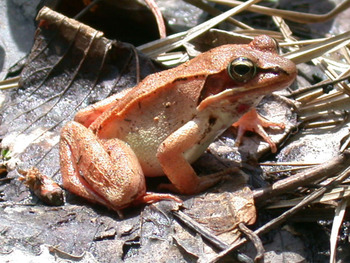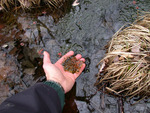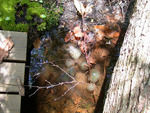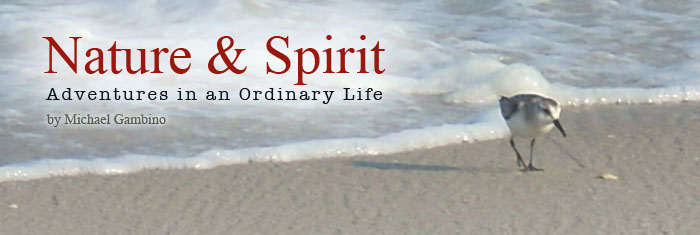Rite of Spring
 Wednesday, March 31, 2010 at 12:01AM
Wednesday, March 31, 2010 at 12:01AM There are a number of events in nature that herald the arrival of spring, and all are wonderful to behold and lift my spirit. Perhaps the most thrilling to me, though, is the sound of Spring Peepers and Wood Frogs calling for a mate. Even on cold nights in early spring, I'll keep the bedroom window slightly open so I can fall asleep listening to the clamorous trilling and quacking calls of these amphibians in wetlands off in the distance. Having spent many hours surveying wetlands for breeding amphibians and other vernal pool species, I know what is going on out there in the dark, cold wetlands. I can lie in bed with eyes closed and feel connected to the rite of spring taking place as it has for millions of years.
 Note the distinctive eye "mask" of adult Wood Frog. (Click to enlarge)Approaching the edge of such a woodland pool at night, the sometimes deafening volume of such singing amphibians literally rattles my brain. With hundreds of individuals dispersed throughout the black water and wet leaves, you would think they'd be easy to see with a flashlight, yet only a few individuals can be seen floating in the water or embraced in the act of mating. Some are seen hopping to and fro on logs or leaves. The vast majority of Wood Frogs and Peepers that are producing such a tremendous sound are hidden very well. In fact, the vibration of their combined intermittent calls make it almost impossible to target an individual. This helps to minimize predation by Raccoons, owls and other predators.
Note the distinctive eye "mask" of adult Wood Frog. (Click to enlarge)Approaching the edge of such a woodland pool at night, the sometimes deafening volume of such singing amphibians literally rattles my brain. With hundreds of individuals dispersed throughout the black water and wet leaves, you would think they'd be easy to see with a flashlight, yet only a few individuals can be seen floating in the water or embraced in the act of mating. Some are seen hopping to and fro on logs or leaves. The vast majority of Wood Frogs and Peepers that are producing such a tremendous sound are hidden very well. In fact, the vibration of their combined intermittent calls make it almost impossible to target an individual. This helps to minimize predation by Raccoons, owls and other predators.
In the relative quiet daylight hours, you can look into the same pond and see egg masses of Wood Frogs and Yellow Spotted salamanders that were deposited during some previous night's primal union. Female Wood Frogs and Yellow-Spotted Salamanders often deposit their eggs on submerged vegetation, branches, or grasses near the surface and in a sunny location to aid incubation. As the egg masses absorb water, they plump up creating a gelatinous protective layer around each egg. This will help protect the embryo from drying out should the water level in the pond temporarily dip low enough to expose the eggs.
The Yellow-Spotted Salamander egg mass is cloudy and whitish, with a secondary gelatinous membrane containing the cluster of individual eggs. As the season progresses, the eggs are colonized by a green algae Oophila amblysomatis. The alga produces oxygen by photosynthesis near the embryo where it is required for development. In turn carbon dioxide, a by-product of the embryo's metabolism, is available to the alga. This symbiotic relationship is just one of the many intricacies of life in a vernal pool (see my Vernal Pools article for more about these critical wetlands). Some salamander eggs don't acquire the algae Oophilais and remain whitish. Those that do get the algae turn green. Apparently, more embryos in the mass survive when Oophila is present. This alga exists in nature exclusively in the eggs of a few species of amphibians. I find this fact to be very intriguing indeed! (Click on photos below to enlarge.)
 Symbiotic algae inside floating egg masses.
Symbiotic algae inside floating egg masses. Wood Frog egg masses spread out when lifted.
Wood Frog egg masses spread out when lifted. Yellow-Spotted Salamander egg masses.Wood Frog egg masses differ in that they have no outer gelatinous envelope to contain the group of individual eggs. Consequently, when lifted gently out of the water in your hand, Wood Frog egg masses tend to spread out whereas the salamander masses retain their plump, firm appearance when lifted from the water. In addition, Wood Frog egg masses are clear, not white, with embryos visible within each egg.
Yellow-Spotted Salamander egg masses.Wood Frog egg masses differ in that they have no outer gelatinous envelope to contain the group of individual eggs. Consequently, when lifted gently out of the water in your hand, Wood Frog egg masses tend to spread out whereas the salamander masses retain their plump, firm appearance when lifted from the water. In addition, Wood Frog egg masses are clear, not white, with embryos visible within each egg.
Eggs hatch between mid-May through June. The tadpoles must complete their development before the water of the pond dries up or dissolved oxygen levels drop too low to survive. Amphibians that are dependent on the temporary nature of ephemeral pools and wetlands have evolved to take advantage of the lack of fish in such bodies of water. The presence of fish populations would ensure that no egg or adult went undigested. Consequently, frogs and salamanders, and other creatures of such vernal (springtime) pools, have adapted to periods of full water and the eventual drying out in late summer.
For more information on the importance of these spring ephemeral pools, read my short article about Vernal Pools.


Reader Comments (1)
I have seen many posts similar to this one on internet but all other have filler content and are not up-to-the mark. This post especially made me to post my comments as its credible, it’s well written and above all it is interactive in nature. Well done!